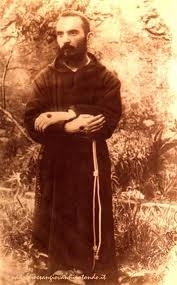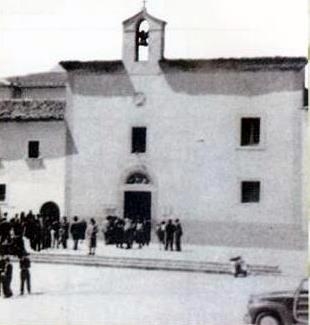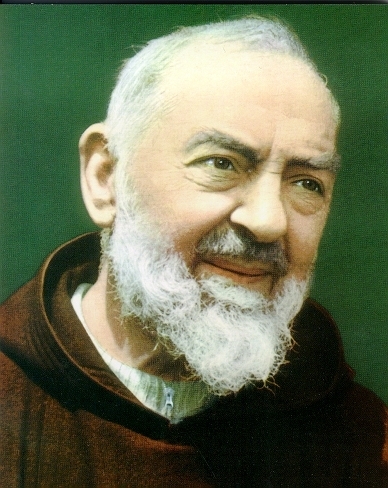 |
| Padre Pio in early priesthood (http://t0.gstatic.com/images) |
What makes a person a hero? Are they a hero if they have their own comic book and can fly? Maybe they do not need a super power but are a hero because they save people from burning buildings, the way a fireman does. For a man called Pio, heroism comes from sticking to what one believes in, and letting it guide them to do what is right. But this man Pio was once a boy, and that boy once a child, and a very sick child at that. Little Pio would always get ill from one thing or another, such as gastroenteritis, typhoid fever, loss of appetite, insomnia, exhaustion, fainting spells, and so much more. With all of these occurring before he even hit 18, it becomes easy to imagine that he became very good friends with the bed he was always confined to. In the midst of this Pio needed something to hold on to. He found that in his faith. His entire family of six was very Catholic and, due to this, Pio took an interest in becoming a priest at a very young age. He was ordained into the priesthood in the year 1904 and devoted the rest of his life to his God. In this time he preached to thousands of people, went into the medical corps for World War I, built a hospital, and more. There are many traits a hero must possess though, among these, two stand out in the crowd. Those two are faith, meaning one will never give up on a person or thing he/she believes in, and humility, meaning a person could not imagine taking credit for something they had done. Padre Pio contains both these traits and exemplifies them throughout his life and, for that reason, he is someone to be revered as a true hero.
Padre Pio was deserving of the many rumors saying he was a great monk. One of the most important things he did to earn this title was to constantly put others before himself. No matter what happened, the suffering of others always came first. Even when at the monastery and sent home for ill health he still, "said mass and taught school." (EWTN), proving that he could work hard even while sick. Pio felt that saying mass was the most important part of his life and it took precedence over all other things. The monk was a stubborn man, and would not give into his pains, so when told to rest he instead taught. Pio often worried for others and their well being, so he did what most do when worried, he built a hospital. "1940 (9 January) Work was started on Padre Pio's 'Grand Earthly Undertaking', namely the building of his 'House for the Relief of Suffering'." (Padre Pio Group). The House for Relief of Suffering was the hospital that he brought to life. It started as just an idea with a few doctors, but several years later the relief house was opened. This was after World War I had just ended so he had plenty of other things to be worried about, but he chose to build a hospital rather than re-gain his strength, yet again pushing himself to his limits for the sake of others. The father was not ever one to take good care of himself, and most likely his cheerfulness to others was what lead to his death, but as long as he eased another's pain it was worth it to him.
 |
| San Giovanni Rotondo (http://www.padrepioinscotland.org.uk/images/PP%) |
Pio was forgiving no matter what happened or what someone did. He had plenty of reason to be angry with many a man, though simply the fact that they were man meant he was compelled to forgive them. Thousands of people adored Padre Pio, but for every person who loved him, another was against him. "Agostino Gemelli, concluded Padre Pio was, 'an ignorant and self-mutilating psychopath who exploited people's credulity.'" (Catholic Online). This man was not the first, nor the last to say that Padre Pio was a fake, but the monk didn't seem to be phased by it. Rather than try to defend his case against these people, he chose to stick to those who did trust him and give them as much wisdom as he could. However, there was a point in his life when, even those who he swore devotion to, turned against him. " 1923 (17 June) Padre Pio was debarred from saying Mass in public or replying to any of the letters arriving at the monastery in San Giovanni Rotondo." (Padre Pio Group). Even though he was kept him isolated from the world outside the walls of the monastery, he did not blame the church that caused his isolation. He quietly accepted whatever was done to him to restrict his teachings for the people. Even when some tried to contact him in secret, he would ask them not to for he knew his allegiance was to the church, whether or not that church made the right choices. Forgiveness can be one of the hardest lessons to learn. Most never understand, yet he was the teacher who showed the example of how to love and forgive those who hate you. But one other heroic trait is left unanswered.
Though the man did many things that would be considered worthy of a celebration, he did not want recognition. In the morning his stern but loving face would be put on with eyes dazzled at other's achievements while masking his own. This was directly showed when Pio said, "I do want to suffer, even to die of suffering, but all in secret." (EWTN). He was always ill, but he was strong enough to put it all behind him and smile for those who needed comfort or knowledge among his many followers. Some say that they will fight for what they believe in, Pio did this by focusing on the achievements of others over his own. But this was not the only time he showed that he was humble; unfortunately in 1968 he showed humility for the last time. In, "1968 (22 September) Padre Pio said Mass at 5 a.m. as usual. This was to be his last celebration of the Eucharist. (23 September) Padre Pio died" (Padre Pio Group). Because Padre Pio did not want people to worry about him, and he wanted to say mass for those who would still listen, even when he was sick he braved through it to ignore his pain for the sake of others. Unfortunately no matter how much he pretended to be healthy, his time still came the next day, and his sickness took his life. The life of this monk was one of hardship and illness, but he would always push that aside so the people surrounding the man would only see him as a regular monk, rather than a brave but weak soul who would deserve their pity. For him being pitied was out of the question and he proved this in many ways.
 |
| Padre Pio (http://www.ciaoitalytours.com/images/tours/tour_382) |
Padre Pio had faith to spare, and no matter what he did he never asked to be recognized, these definite truths show the heroism he always had. Seeing how someone is a hero can be an irksome task, though Pio made that much easier by being one every day in the ways that he put others first, always forgave, and stayed so very humble. This man is truly an inspiration with the way he can stay on the path he knew was right, like an arrow flying upward straight and true, never wavering. This is why a man or woman becomes a hero, because they refuse to stop doing what is right and just. The priest bestowed the name Pio felt his path was to be Catholic and even his last words were the names of two extremely important people of that faith, Jesus, and Mary. So Padre Pio had no cape, no comic books, and he didn't even save a child from a burning building, but what he did have, he held on to. He made his teachings and actions a light at the end of a tunnel for many people and therefore, he was, and is, a hero.
Works Consulted
"Padre Pio Group - Official Site." Padre Pio Group. Web. 09 May 2012.
"Ain't No Other Man." : Saint Padre Pio of Pietrelcina: Man of Hope. Web. 17 May 2012.
"Friaries of Padre Pio - Padre Pio in Scotland." Friaries of Padre Pio - Padre Pio in Scotland. Web. 17 May 2012.
"Maite Kelly | Portraits." Maite Kelly | Portraits. Web. 17 May 2012.
Miklas, S. F. "Padre Pio." New Catholic Encyclopedia. Detroit: Gale, 2003. Gale Biography In
Context. Web. 30 Apr. 2012.
Murphy, Bruce. "The legacy." Commonweal 134.4 (2007): 38. Gale Biography In Context. Web. 30 Apr.
2012.
Padre Pio The Man - Biography." Padre Pio The Man - Biography. EWTN. Web. 08 May 2012.
Page created on 5/20/2012 1:26:28 PM
Last edited 5/20/2012 1:26:28 PM
